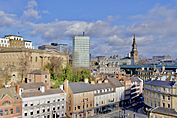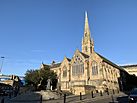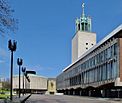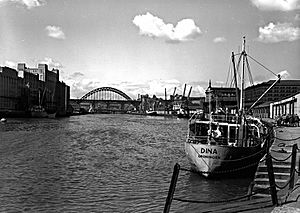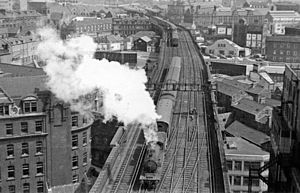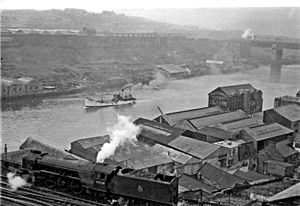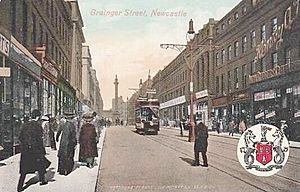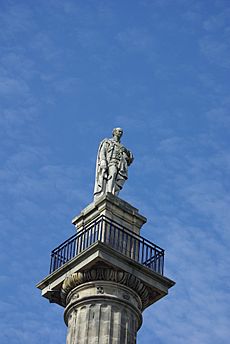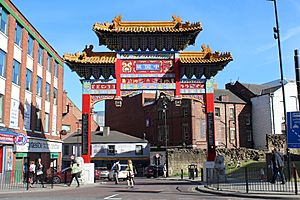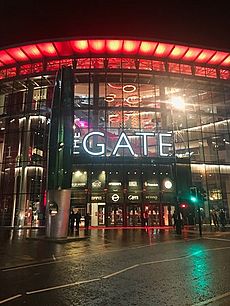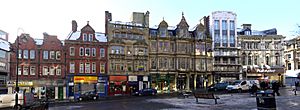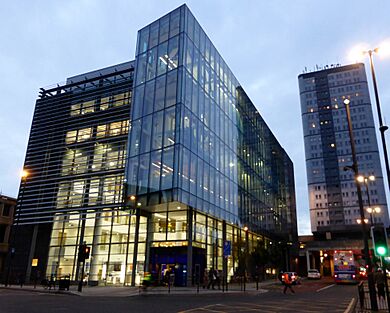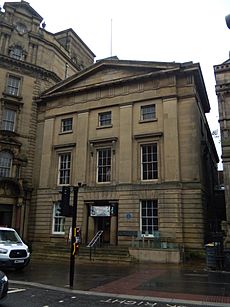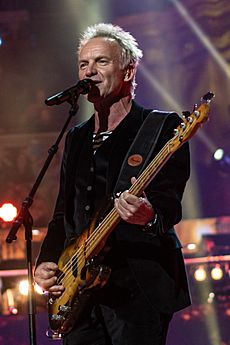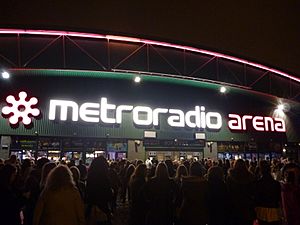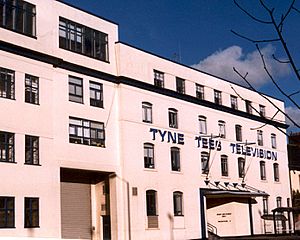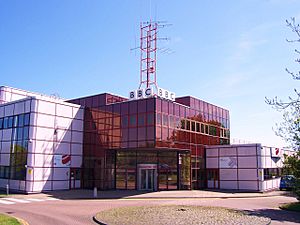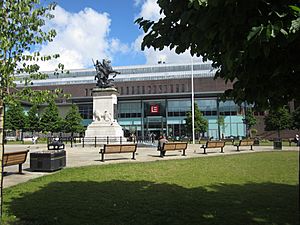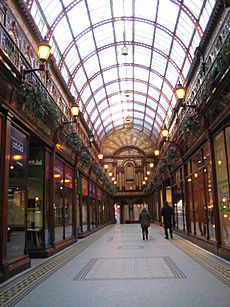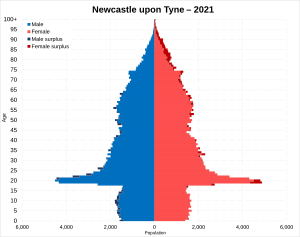Newcastle upon Tyne facts for kids
Quick facts for kids
Newcastle upon Tyne
|
||
|---|---|---|
|
The Quayside, with the Tyne Bridge to the left and the Millennium Bridge to the centre right
Grainger Town
The Civic Centre
|
||
|
||
| Nickname(s):
The Toon
|
||
| Motto(s): | ||
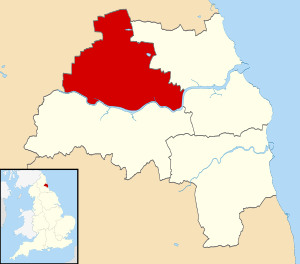
Newcastle shown within Tyne and Wear
|
||
| Sovereign state | United Kingdom | |
| Country | England | |
| Region | North East | |
| Ceremonial county | Tyne and Wear | |
| City region | North East | |
| Founded | 2nd century AD | |
| City status | 1882 | |
| Metropolitan borough | 1 April 1974 | |
| Administrative HQ | Newcastle Civic Centre | |
| Government | ||
| • Type | Metropolitan borough | |
| • Body | Newcastle City Council | |
| Area | ||
| • Total | 44 sq mi (115 km2) | |
| • Land | 43.8 sq mi (113.5 km2) | |
| Area rank | 205th | |
| Population
(2005 est.)
|
||
| • Total | 302,820 | |
| • Rank | 43rd | |
| Demonym(s) |
|
|
| Ethnicity (2021) | ||
| • Ethnic groups |
List
|
|
| Religion (2021) | ||
| • Religion |
List
41.3% Christianity
40.8% no religion 9.0% Islam 1.4% Hinduism 0.5% Sikhism 0.5% Buddhism 0.2% Judaism 0.4% other 6.0% not stated |
|
| Time zone | UTC+0 (GMT) | |
| • Summer (DST) | UTC+1 (BST) | |
| Postcode area |
|
|
| Dialling code | 0191 | |
| ISO 3166 code | GB-NET | |
| GSS code | E08000021 | |
Newcastle upon Tyne, often called Newcastle, is a vibrant city in Tyne and Wear, England. It's the most northern big city in England, sitting on the north side of the River Tyne. Right across the river is its neighbour, Gateshead. Newcastle is the biggest city in the Tyneside area and the whole North East region.
The city started as a Roman settlement called Pons Aelius. Later, it was known as Monkchester. It got its current name from a castle built in 1080 by William the Conqueror's son, Robert Curthose. During the Industrial Revolution, Newcastle was a major hub for ship building and repairs. It was historically part of Northumberland but became its own county in 1400. In 1974, Newcastle joined Tyne and Wear. The local government is the Newcastle City Council.
Contents
- History of Newcastle
- Geography of Newcastle
- Culture and Fun in Newcastle
- Landmarks to See
- Media and Communications
- Economy and Business
- Population and People
- Sports in Newcastle
- Getting Around Newcastle
- Education in Newcastle
- Religious Buildings
- Famous People from Newcastle
- International Connections
- See also
History of Newcastle
Ancient Roman Times
The first known settlement in Newcastle was a Roman fort and bridge called Pons Aelius. It was named after the Roman Emperor Hadrian, who started it in the 2nd century AD. This special honour suggests Hadrian might have visited the site himself. About 2,000 people lived there back then.
You can still see parts of Hadrian's Wall in Newcastle, especially along West Road. This wall stretched 73 miles (117 km) across Britain. It was built mainly for defence to stop tribes from the north, like the Picts, from invading.
Anglo-Saxon and Norman Eras
After the Romans left Britain around 410 AD, Newcastle became part of the powerful Anglo-Saxon kingdom of Northumbria. It was known as Munucceaster, or Monkchester.
In 876, conflicts with the Danes left many settlements along the River Tyne in ruins. Later, in 1088, Monkchester was almost completely destroyed during a rebellion against the Normans.
Because of its important location, Robert Curthose, son of William the Conqueror, built a wooden castle here in 1080. From then on, the town was called Novum Castellum, meaning New Castle. A stone castle replaced the wooden one in 1087. It was rebuilt again in 1172, and much of the castle keep you see today is from that time.
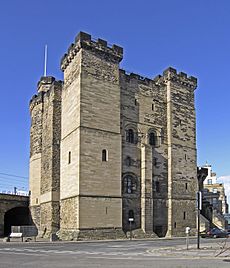
Medieval Period
During the Middle Ages, Newcastle was England's northern stronghold. In 1400, King Henry IV made Newcastle a separate county, independent from Northumberland.
A 25-foot (7.6 m) high stone wall was built around the town in the 13th century. This wall helped defend Newcastle from Scottish invaders during the Border wars. The Scottish king William the Lion was held prisoner in Newcastle in 1174. King Edward I also brought the Stone of Scone and William Wallace through the town. Newcastle successfully defended itself against the Scots three times in the 14th century.
From the 16th to 19th Centuries
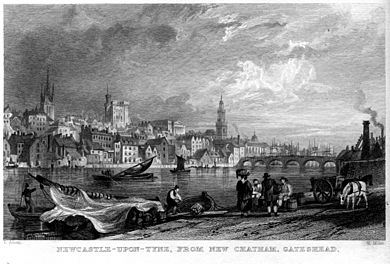
From 1530, a royal law meant that all coal from Tyneside had to be shipped from Newcastle Quayside. This gave a group of Newcastle merchants, called the Hostmen, control over the coal trade. This control helped Newcastle become a very important town. The saying taking coals to Newcastle, meaning to do something pointless, comes from this time.
In the 1630s, a serious illness affected Newcastle. About 7,000 out of 20,000 people died, which was more than a third of the population.
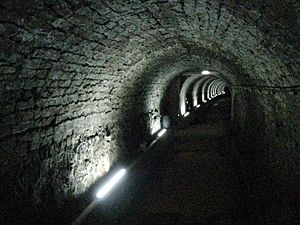
During the English Civil War, the North supported the King. In 1644, Newcastle was attacked and taken by Cromwell's allies, the Scots. The King later gave the city its motto: "Fortiter Defendit Triumphans" ("Triumphing by a brave defence"). King Charles I was held prisoner in Newcastle in 1646–47.
Newcastle was the fourth largest printing centre in England. The Literary and Philosophical Society, founded in 1793, was a place for smart discussions and had many books. Newcastle also became known for making beautiful glass.
The city was granted city status on 3 June 1882. In the 19th century, shipbuilding and heavy engineering were key to Newcastle's success. The city was a powerhouse of the Industrial Revolution. This led to the city growing rapidly.
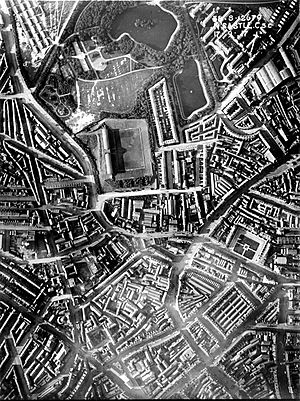
Inventions from Newcastle and nearby areas include safety lamps, Stephenson's Rocket (a famous steam engine), Lord Armstrong's artillery, and Joseph Swan's electric light bulbs. In 1879, Mosley Street in Newcastle was the first public road in the world to be lit by the incandescent lightbulb. Newcastle was one of the first cities to have electric lighting.
20th and 21st Centuries
Newcastle's public transport was updated in 1901 with electric trams. These were later replaced by trolley buses, and the tram service ended in 1950.
The city got its first art gallery, the Laing Art Gallery, in 1904. The Tyne Bridge opened in 1928, improving road links.
During the Second World War, Newcastle was a target for air raids because of its important industries like shipbuilding. The raids caused many deaths and injuries.
The University of Durham's college in Newcastle became Newcastle University in 1963. Newcastle Polytechnic became Northumbria University in 1992.
New developments in the early 2000s included the Life Science Centre in 2000 and the Millennium Bridge in 2001.
Newcastle United F.C. has been based at St James' Park since 1886. They have won four top division titles and six FA Cups. In 1996, they bought Alan Shearer, a famous England striker, for a world record fee.
In 2017, Newcastle hosted the Freedom City festival, celebrating 50 years since Dr Martin Luther King's visit to Newcastle University. In 2018, the city held the Great Exhibition of the North, showcasing the North of England's innovators and artists. In 2019, Newcastle was named the friendliest city in the UK by various travel sites.
Geography of Newcastle
Newcastle is part of the metropolitan county of Tyne and Wear in North East England. It's on the north-west bank of the River Tyne, about 46 miles (74 km) south of the Scottish border.
The city still has a medieval street layout in many parts. Narrow alleys called 'chares' are common, especially near the riverside. You can still find stairs from the riverside up to higher parts of the city centre.
Newcastle has a beautiful neoclassical city centre, known as Tyneside Classical. It was mostly built in the 1830s by Richard Grainger and John Dobson. Many of these buildings have been carefully restored. Writer Stuart Maconie called Newcastle England's best-looking city. The famous architect Nikolaus Pevsner described Grey Street as one of England's finest streets. In 2005, it was voted England's best street by BBC Radio 4 listeners.
Just north-west of the city centre is Leazes Park, which opened in 1873. Next to it is St James' Park, the home stadium of Newcastle United FC, which stands out in the city's skyline.
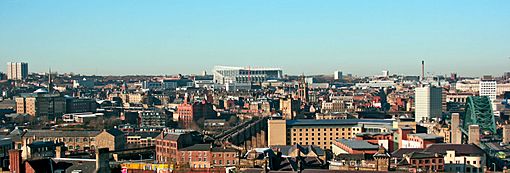
Another large green space is the Town Moor, north of the city centre. It's bigger than London's Hyde Park and Hampstead Heath combined. The freemen of the city have the right to graze cattle there. The Hoppings funfair, one of Europe's largest travelling funfairs, is held here every June.
Ouseburn Valley
The wooded valley of the Ouseburn in the east of the city is called Jesmond Dene. It's a popular recreation area, connected to Armstrong Park and Heaton Park. The Ouseburn river eventually flows into the River Tyne.
The Quayside Area
The area along the Tyne Gorge, between Newcastle and Gateshead, is known as the Newcastle-Gateshead Quayside. It's famous for its amazing bridges, like the Tyne Bridge (1928), Robert Stephenson's High Level Bridge (1849), and the Swing Bridge (1876).
Many old shipping buildings have been replaced with modern offices. The unique Gateshead Millennium Bridge connects the Newcastle Quayside with the Gateshead Quayside. Here you'll find the BALTIC Centre for Contemporary Art and The Sage Gateshead music centre. The Quaysides are now lively areas with bars, restaurants, and hotels.
Grainger Town's Architecture
The historic heart of Newcastle is Grainger Town. It was built by Richard Grainger, a developer, between 1835 and 1842. Some of Newcastle's most beautiful buildings and streets are here, including Grainger Market, Theatre Royal, Grey Street, Grainger Street, and Clayton Street. These buildings are usually four stories high with domes and turrets. Richard Grainger is famous for changing Newcastle from a town of bricks and wood to one of stone. Many of Grainger Town's buildings are listed as historically important.
Grey's Monument honours Prime Minister Earl Grey and his Reform Act of 1832. It stands above Monument Metro Station.
The Grainger Market opened in 1835 and was Newcastle's first indoor market. It was considered one of the largest and most beautiful markets in Europe at the time.
Chinatown in Newcastle
Newcastle's busy Chinatown is in the north-west of Grainger Town, mainly on Stowell Street. A new Chinese arch, or paifang, was given to the city in 2005, marking the entrance to this area.
City Housing
The Tyneside flat was a common type of housing built when industries were growing fast in Tyneside. These flats were built in rows, with one door leading to an upstairs flat and another to a ground-floor flat. Each flat usually had two or three rooms.
The Byker Wall, designed by Ralph Erskine in the 1960s, is a famous housing development in Newcastle. It is now a Grade II* listed building and is on UNESCO's list of important 20th-century buildings.
Newcastle's Climate
Newcastle has an oceanic climate. It's one of the driest cities in the UK because it's in the rain shadow of the North Pennines. Winters can be cool to cold, but generally warmer than the countryside around it. Summers are often warm with very long daylight hours, more than most other major English cities. Newcastle upon Tyne is at the same latitude as Copenhagen in Denmark.
| Climate data for Newcastle (Met Office Durham) Extremes Newcastle | |||||||||||||
|---|---|---|---|---|---|---|---|---|---|---|---|---|---|
| Month | Jan | Feb | Mar | Apr | May | Jun | Jul | Aug | Sep | Oct | Nov | Dec | Year |
| Record high °C (°F) | 14.0 (57.2) |
14.0 (57.2) |
21.0 (69.8) |
21.0 (69.8) |
25.0 (77.0) |
26.0 (78.8) |
37.0 (98.6) |
32.5 (90.5) |
21.0 (69.8) |
20.0 (68.0) |
18.0 (64.4) |
15.0 (59.0) |
37.0 (98.6) |
| Mean daily maximum °C (°F) | 6.6 (43.9) |
7.2 (45.0) |
9.5 (49.1) |
11.9 (53.4) |
15.0 (59.0) |
17.6 (63.7) |
20.1 (68.2) |
19.8 (67.6) |
17.2 (63.0) |
13.3 (55.9) |
9.4 (48.9) |
6.7 (44.1) |
12.9 (55.2) |
| Daily mean °C (°F) | 3.8 (38.8) |
4.1 (39.4) |
5.9 (42.6) |
7.8 (46.0) |
10.6 (51.1) |
13.3 (55.9) |
15.6 (60.1) |
15.4 (59.7) |
13.1 (55.6) |
9.8 (49.6) |
6.4 (43.5) |
3.9 (39.0) |
9.2 (48.6) |
| Mean daily minimum °C (°F) | 0.9 (33.6) |
0.9 (33.6) |
2.3 (36.1) |
3.7 (38.7) |
6.1 (43.0) |
9.0 (48.2) |
11.1 (52.0) |
11.0 (51.8) |
9.0 (48.2) |
6.3 (43.3) |
3.4 (38.1) |
1.1 (34.0) |
5.4 (41.7) |
| Record low °C (°F) | −12.6 (9.3) |
−3.0 (26.6) |
−9.0 (15.8) |
−2.0 (28.4) |
−1.0 (30.2) |
1.0 (33.8) |
6.0 (42.8) |
3.0 (37.4) |
0.0 (32.0) |
−5.0 (23.0) |
−11.0 (12.2) |
−14.0 (6.8) |
−14.0 (6.8) |
| Average rainfall mm (inches) | 52.3 (2.06) |
41.8 (1.65) |
44.6 (1.76) |
52.7 (2.07) |
44.2 (1.74) |
55.4 (2.18) |
54.0 (2.13) |
60.8 (2.39) |
55.4 (2.18) |
60.9 (2.40) |
72.0 (2.83) |
57.0 (2.24) |
651.1 (25.63) |
| Average rainy days (≥ 1.0 mm) | 11.4 | 9.3 | 9.7 | 9.5 | 9.2 | 9.7 | 9.0 | 9.6 | 9.3 | 11.3 | 12.3 | 11.7 | 122 |
| Mean monthly sunshine hours | 58.6 | 80.3 | 115.5 | 150.3 | 181.7 | 164.8 | 172.3 | 167.3 | 134.5 | 102.8 | 66.4 | 51.2 | 1,445.4 |
| Source: Met Office | |||||||||||||
| Month | Jan | Feb | Mar | Apr | May | Jun | Jul | Aug | Sep | Oct | Nov | Dec | Year |
|---|---|---|---|---|---|---|---|---|---|---|---|---|---|
| Mean daily maximum °C (°F) | 8.2 (46.8) |
8.5 (47.3) |
10.2 (50.4) |
12.1 (53.8) |
14.9 (58.8) |
17.2 (63.0) |
19.1 (66.4) |
18.9 (66.0) |
17.0 (62.6) |
13.8 (56.8) |
10.6 (51.1) |
8.5 (47.3) |
13.3 (55.9) |
| Daily mean °C (°F) | 5.4 (41.7) |
5.4 (41.7) |
6.8 (44.2) |
8.2 (46.8) |
10.7 (51.3) |
13.2 (55.8) |
15.1 (59.2) |
15.0 (59.0) |
13.2 (55.8) |
10.5 (50.9) |
7.6 (45.7) |
5.7 (42.3) |
9.7 (49.5) |
| Mean daily minimum °C (°F) | 2.5 (36.5) |
2.3 (36.1) |
3.3 (37.9) |
4.2 (39.6) |
6.5 (43.7) |
9.2 (48.6) |
11.1 (52.0) |
11.0 (51.8) |
9.4 (48.9) |
7.1 (44.8) |
4.5 (40.1) |
2.9 (37.2) |
6.2 (43.1) |
| Average rainfall mm (inches) | 106.6 (4.20) |
74.8 (2.94) |
80.4 (3.17) |
63.2 (2.49) |
66.8 (2.63) |
68.3 (2.69) |
60.5 (2.38) |
81.8 (3.22) |
73.6 (2.90) |
100.0 (3.94) |
105.3 (4.15) |
101.9 (4.01) |
983.2 (38.72) |
| Average rainy days | 14.2 | 10.6 | 12.7 | 10.4 | 11.2 | 10.1 | 10.0 | 11.3 | 10.0 | 13.0 | 13.4 | 13.2 | 140.1 |
| Source: WMO | |||||||||||||
Green Spaces and Environment
Newcastle is located within the North East Green Belt. This area helps prevent towns from merging and protects the countryside. It also encourages the reuse of old urban land.
The city has been recognized for its efforts to protect the environment. Newcastle aims to become a "carbon neutral" city by 2050, meaning it will balance its carbon emissions with carbon removal.
Culture and Fun in Newcastle
Nightlife and Entertainment
The Rough Guide to Britain once called Newcastle upon Tyne's nightlife the best tourist attraction in Great Britain. On Tripadvisor, Newcastle was ranked third in Europe for nightlife. In July 2023, it was voted the best UK city for food, fashion, and nightlife.
Many bars are found on the Bigg Market and nearby streets. Other popular areas include Collingwood Street, known as the 'Diamond Strip' for its fancy bars. "The Gate" on Newgate Street is a popular spot for evening entertainment.
Food and Local Treats
The bakery chain Greggs started in Newcastle and has its main office here. Newcastle has the most Greggs stores per person in the world! Local foods include pease pudding and stottie cake.
In 1967, Salt & Vinegar flavour crisps were first made by Tudor Crisps, a company based in Newcastle. They were tested in the North East before being sold everywhere. Newcastle also has its own Chinatown with many restaurants.
The city offers a wide range of international foods, including Greek, Mexican, Spanish, Indian, Italian, Japanese, and more. There are also many excellent gourmet restaurants.
Theatre and Shows
The city has a long history of theatre. The largest theatre is the Theatre Royal on Grey Street, which opened in 1837. It hosts performances from the Royal Shakespeare Company and touring musicals.
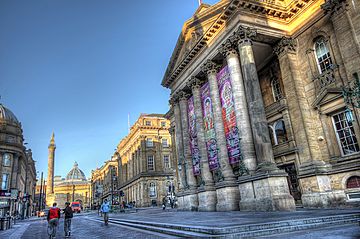
Other theatres include the Mill Volvo Tyne Theatre, Northern Stage, Live Theatre, and the People's Theatre. In 2006, NewcastleGateshead was voted the UK's arts capital.
Books and Libraries
Newcastle is known as a poetry centre. The Morden Tower is a key place for poetry readings.
The Literary and Philosophical Society of Newcastle upon Tyne (called the 'Lit & Phil') is the biggest independent library outside London, with over 150,000 books. Its building, designed by John and Benjamin Green, opened in 1825. Its lecture theatre was the first public building to be lit by electric light in 1880.
The new Newcastle City Library opened in 2009 and was named after the local composer Charles Avison. Queen Elizabeth II officially opened it later that year.
Seven Stories, the National Centre for Children's Books, opened in 2005 in the Ouseburn Valley.
Festivals and Events
- In January or February, Newcastle's Chinatown celebrates Chinese New Year with parades.
- The Newcastle Science Festival, now Newcastle ScienceFest, happens every March.
- The Newcastle Beer Festival takes place in April.
- The Hoppings, Europe's largest travelling funfair, comes to Newcastle Town Moor every June.
- The Northern Pride Festival and Parade is held in Leazes Park in mid-July.
- The Ouseburn Festival, a family-friendly event, is held in late July.
- Newcastle Mela, a two-day multicultural event with music and food, is held in late August.
Music Scene
Newcastle has a rich music history. In the 1960s, the famous rock group The Animals started here. Other well-known artists with ties to the city include Sting, Bryan Ferry, and Dire Straits.
Lindisfarne is a folk-rock group from Tyneside. Their song "Fog on the Tyne" is very famous. Venom, a band that helped create black metal, formed in Newcastle in 1979. Brian Johnson was in the local band Geordie before becoming the singer for AC/DC.
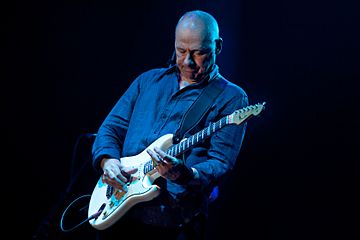
Newcastle is home to Kitchenware Records, which signed bands like Prefab Sprout. The members of Lighthouse Family met at Newcastle University.
Concert Venues
The biggest place for music concerts is St James' Park, home of Newcastle United. The second largest is the 11,000-seat Utilita Arena Newcastle, which opened in 1995 and hosts big pop and rock shows. Newcastle City Hall is one of the oldest venues in the area.
On 14 October 2005, the 2,000-capacity NX Newcastle opened. It used to be a music venue in the 1960s, hosting bands like The Beatles. Since reopening, it has hosted many major artists, including Adele and Arctic Monkeys.
The Riverside music venue, open from 1985 to 1999, hosted Nirvana's first European show in 1989. It also welcomed Oasis and David Bowie.
Landmarks to See
Newcastle's famous landmarks include the Tyne Bridge, the Swing Bridge, Newcastle Castle, Newcastle Cathedral, St Mary's Cathedral, St Thomas' Church, Grainger Town (with Grey's Monument and the Theatre Royal), the Millennium Bridge, St James' Park, and Chinatown.
Media and Communications
TV and Film in Newcastle
Many films have been shot in Newcastle. Get Carter (1971) was filmed around the city, showing what Newcastle looked like in the early 1970s. Stormy Monday (1988), starring Tommy Lee Jones and Sting, also used Newcastle as a backdrop. More recently, I, Daniel Blake (2016), which won the top award at the Cannes Film Festival, was filmed here.
Football-themed films like Purely Belter (2000) and Goal! have also been set in Tyneside. The Bollywood film Hum Tum Aur Ghost (2010) was filmed in Newcastle city centre.
Local Newspapers
Local newspapers printed in Newcastle include the Evening Chronicle, The Journal, and the Sunday Sun. The Crack is a monthly magazine about style and events. The adult comic Viz started in Jesmond and often mentions Newcastle.
Television and Radio
BBC North East and Cumbria is based in Newcastle and broadcasts the Look North regional news and local radio station BBC Radio Newcastle.
ITV Tyne Tees was based in the city for over 40 years. Its former studio entrance gave its name to the 1980s music TV show, The Tube.
Local radio stations include Hits Radio North East and Greatest Hits Radio North East. Capital North East and Heart North East also broadcast from the city. NE1fm launched in 2007 as the first full-time community radio station in the area.
City-wide Wi-Fi
Newcastle was one of the first UK cities to offer free wireless internet access in its city centre. It was set up in 2006 and started working in March 2007.
Economy and Business
Newcastle's economy is varied, with important contributions from science, finance, retail, education, tourism, and nightlife. It's one of the UK's Core Cities.
In the 19th century, Newcastle was a major centre for coal mining, shipbuilding, and engineering during the Industrial Revolution. However, heavy industries declined in the second half of the 20th century. Now, jobs in offices, services, and retail are the city's main focus.
Today, Newcastle's economy adds about £13 billion to the UK's economy. The city's lively nightlife alone is worth an estimated £340 million each year.
The UK's first biotechnology village, the Centre for Life, is near Central Station. This is part of the City Council's plan to make Newcastle a science city.
Shopping in Newcastle
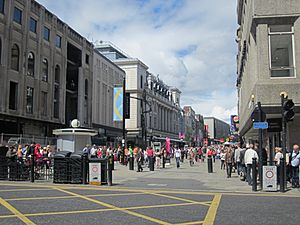
In 2010, Newcastle was ranked ninth in the UK for retail spending. The biggest shopping area in Newcastle City Centre is the Eldon Square Shopping Centre, one of the largest city centre shopping complexes in the UK. It has one of the biggest John Lewis & Partners stores in the UK. This John Lewis store used to be called Bainbridge, which started in 1838 and is often called the world's first department store.
The main shopping street is Northumberland Street. It's home to the first and largest Fenwick department store and a large Marks and Spencer store.
Other shopping spots include Grainger Street, the area around Grey's Monument, Eldon Garden, Monument Mall, Central Arcade, and the traditional Grainger Market.
Close to Newcastle, in Gateshead, is the MetroCentre, one of the largest indoor shopping centres in Europe.
Population and People
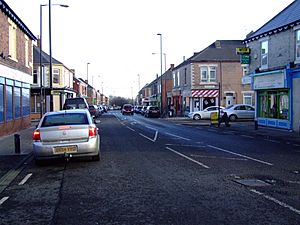
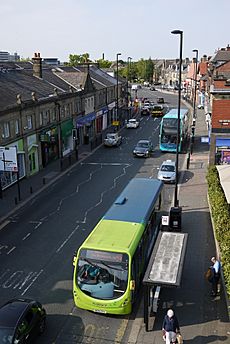
In 2015, Newcastle had a population of 293,000. The wider Tyneside area, including Newcastle, Gateshead, North Tyneside, and South Tyneside, has about 880,000 people.
Newcastle is also home to many students from Newcastle University and Northumbria University. Areas like Jesmond, Shieldfield, and Heaton have large student populations.
| Year | Population | |
|---|---|---|
| 1801 | 33,322 |
|
| 1851 | 80,184 |
|
| 1901 | 246,905 |
|
| 1911 | 293,944 |
|
| 1921 | 309,820 |
|
| 1931 | 326,576 |
|
| 1941 | 333,286 |
|
| 1951 | 340,155 |
|
| 1961 | 323,844 |
|
| 1971 | 308,317 |
|
| 1981 | 272,923 |
|
| 1991 | 277,723 |
|
| 2001 | 259,573 |
|
| 2011 | 292,200 |
|
| 2019 | 302,820 |
|
Who Lives in Newcastle?
Age Groups
The average age of people in Newcastle is 37.8 years, which is slightly younger than the UK national average of 38.6 years.
Religious Beliefs
From the 2011 Census, the main religions in Newcastle were Christianity (56.6%) and Islam (6.3%). Over 28% of people said they had no religious affiliation.
Different Backgrounds
According to the 2011 census, most of Newcastle's population (85.3%) was white. Asians made up 9.8% of the population, including people from Pakistan, Bangladesh, India, and China. Black people made up a smaller part of the population (1.7%).
Large communities of different ethnic backgrounds can be found in areas like Elswick and Arthurs Hill.
Geordies: People of Newcastle
The local nickname for people from Newcastle and the surrounding area is Geordie. The Latin word Novocastrian can also be used, especially for former students of the city's Royal Grammar School.
The Geordie Dialect
The way people speak in Newcastle is also called Geordie. It has many unique words and pronunciations not found in other parts of the UK. The Geordie dialect comes from the language spoken by the Anglo-Saxon people who settled in England after the Romans left. While other English dialects changed a lot due to influences like Latin and Norman French, Geordie kept many old words.
For example, "dead" is pronounced "deed," "cow" is "coo," and "home" is "hyem." These are similar to how they were said in Anglo-Saxon. Words like "bairn" (child) and "hyem" (home) also have roots in Scandinavian languages. Some Geordie words are used elsewhere in Northern England, like "bonny" (pretty) and "aye" (yes). However, many words are unique to Newcastle, such as "canny" (meaning "good" or "nice"), "hacky" (dirty), and "netty" (toilet).
Sports in Newcastle
Newcastle has a strong tradition in sports.
Football Teams
Newcastle United F.C., a Premier League football club, has been based at St James' Park since 1892. The stadium can hold over 52,000 spectators, making it England's seventh largest football stadium.
Newcastle also has a women's football team, Newcastle United Women's Football Club, founded in 1989.
St James' Park was one of the host venues for the 2012 London Olympic Games, hosting nine football matches.
Running Events
Newcastle is the starting point for the annual Great North Run, the world's largest half-marathon. Runners cross the Tyne Bridge into Gateshead and finish 13.1 miles (21.1 km) away at South Shields. Another race is the 5.9-mile (9.5 km) Blaydon Race, held every June 9th.
Rugby and Other Sports
The Newcastle Falcons are the city's main rugby union team, playing at Kingston Park Stadium. Newcastle was one of the host cities for the 2015 Rugby World Cup, with St James' Park hosting three matches.
Newcastle Thunder is the city's professional rugby league club, also playing at Kingston Park Stadium. The Super League Magic Weekend has been held at St James' Park every year since 2015.
The city also has several cricket clubs, field hockey clubs, and a horse racing course at Gosforth Park. The Newcastle Eagles are a successful professional basketball team. The city also has a speedway team, the Newcastle Diamonds.
Getting Around Newcastle
Air Travel
Newcastle International Airport is located just outside the city. It's the largest and busiest airport in North East England, handling over five million passengers each year. As of 2007, it had flights to 90 destinations worldwide.
The airport is connected to Central Newcastle by the Tyne and Wear Metro. A journey between Central Station Metro station and Newcastle Airport Metro station takes about 20 minutes.
Train Services
Newcastle Central Station is a major stop on the East Coast Main Line. Train companies like London North Eastern Railway offer frequent services to London King's Cross and north to Edinburgh. CrossCountry trains link Newcastle to destinations in the Midlands and South West.
In 2014, the station's historic entrance was refurbished. It's one of only six Grade One listed railway stations in the UK. Opened in 1850 by Queen Victoria, it was the world's first covered railway station.
Metro System
The city has the Tyne and Wear Metro, a system of suburban and underground railways. It opened in phases between 1980 and 1984 and was Britain's first urban light rail system. It uses a mix of old and new tracks, with tunnels under Central Newcastle. A bridge was built across the Tyne for the Metro, opened by Queen Elizabeth II in 1981.
The Metro has two lines. The Green line runs from Newcastle Airport through Central Newcastle to South Hylton in Sunderland. The Yellow line goes from St James towards Whitley Bay, then back to Central Newcastle, and on to South Shields.
The system is currently being updated with new ticket machines, gates, and refurbished trains and stations.
Road Network
Major roads include the A1 (Newcastle Gateshead Western Bypass), which goes north to Edinburgh and south to London. The A19 heads south towards York. The A69 goes west to Carlisle. The A1058 "Coast Road" runs from Jesmond to the east coast. In 2011, a second Tyne Tunnel was built to increase traffic capacity.
Bus Services Bus services are run by companies like Stagecoach North East, Go North East, and Arriva North East. Stagecoach North East operates most city services. Go North East connects Newcastle with areas south of the Tyne. Arriva North East serves the north of the city. The QuayLink connects Newcastle and Gateshead to the Quayside. Newcastle Central coach station is the main hub for long-distance bus services.
Cycling Routes
Newcastle has several cycle routes that are mostly traffic-free, leading to the city centre. The C2C cycle route runs along the north bank of the River Tyne, allowing cyclists to travel off-road to North Shields and Tynemouth in the east, and west towards Hexham.
The city council aims to improve cycling by developing more cycle networks, making routes safer, and increasing bike parking. They also work with employers to encourage cycling to work.
Ferry Services
DFDS Seaways runs a ferry service from Newcastle International Ferry Terminal (in North Shields) to IJmuiden, near Amsterdam in The Netherlands.
Education in Newcastle
Schools and Colleges
Newcastle has 74 primary schools and 20 secondary schools. Most are funded by the local authority, but 7 are fee-paying independent schools.
Some well-known secondary schools include Walker Riverside Academy, Gosforth Academy, and St Cuthbert's High School. The largest independent schools are the Royal Grammar School (co-educational) and Newcastle High School for Girls.
Newcastle College is the largest further education college in North East England.
Universities in the City
Newcastle has two main universities: Newcastle University and Northumbria University.
Newcastle University started as the Durham University School of Medicine and Surgery in 1834. It became fully independent in 1963. It's a red brick university and a member of the Russell Group, which includes top research-focused UK universities. It won the Sunday Times University of the Year award in 2000.
Northumbria University began as Newcastle Polytechnic in 1969 and became a university in 1992. It was voted 'Best New University' by The Times Good University Guide 2005.
Museums and Art Galleries
Newcastle has several museums and galleries:
- The Centre for Life with its Science Village.
- The Discovery Museum, which shows life on Tyneside, including its shipbuilding history and inventions.
- The Great North Museum, which combined with the Newcastle on Tyne Museum of Antiquities in 2009.
- Seven Stories, the National Centre for Children's Books.
- The Side Gallery, featuring historical and modern photography.
- The Laing Art Gallery, whose collections are available online through the Google Cultural Institute.
Religious Buildings
Newcastle has three cathedrals: the Anglican St Nicholas' (known for its lantern tower from 1474), the Roman Catholic St Mary's (designed by Augustus Welby Pugin), and the Coptic Orthodox Cathedral in Fenham. All three started as parish churches.
The Church of St Thomas the Martyr is unique as a Church of England church without its own parish.
The Parish Church of St Andrew is thought to be the oldest church in Newcastle, with parts dating back to the 12th century. It has more old stonework than any other church in the city.
Famous People from Newcastle
- Charles Avison, a leading 18th-century composer.
- Basil Hume, a former Archbishop.
- Cuthbert Collingwood, a Vice Admiral.
- Lord Armstrong, a famous engineer and industrialist.
- George Stephenson, engineer and father of modern railways.
- Robert Stephenson, also an engineer.
- Sir Charles Parsons, inventor of the steam turbine.
- Sir Joseph Swan, inventor of the incandescent light bulb.
- Rowan Atkinson, actor and comedian.
- Sir Jonathan Ive, industrial designer (known for Apple products).
- Basil Bunting, a modernist poet.
- Eça de Queiroz, a Portuguese writer.
- Abhisit Vejjajiva, former Prime Minister of Thailand.
- Cheryl, musician.
- Eric Burdon, musician.
- Sting, musician.
- Mark Knopfler, musician.
- The Lighthouse Family, musicians.
- Brian Johnson, musician (from AC/DC).
- Ant & Dec, famous TV entertainers.
- Alan Shearer, famous footballer.
- Peter Higgs, Nobel Prize-winning physicist.
- Benjamin Satterley, wrestler.
- Kathryn Tickell, a celebrated Northumbrian piper.
International Connections
Twin Towns and Sister Cities
Newcastle upon Tyne is twinned with:
- Newcastle, Australia
- Atlanta, Georgia, U.S. (since 1977)
- Groningen, Netherlands
- Bergen, Norway (since 1968)
- Gelsenkirchen, Germany (since 1948)
- Haifa, Israel
- Nancy, France (since 1954)
- Taiyuan, China (since 1985, but Newcastle ended this in 2022)
Other Agreements
Newcastle also has "friendship agreements" with Little Rock, Arkansas in the U.S. and a "special cooperation agreement" with Malmö, Sweden.
In 1998, Newcastle participated in a meeting of worldwide cities named Newcastle. This led to friendship agreements with places like:
- Neuburg an der Donau, Germany
- Neuchâtel, Switzerland
- Neufchâteau, Vosges, France
- New Castle, Delaware, United States
- New Castle, Indiana, United States
- New Castle, Pennsylvania, United States
- Newcastle-under-Lyme, England
- Newcastle, KwaZulu-Natal, South Africa
- Shinshiro, Japan
Foreign Consulates
Several countries have consular offices in Newcastle, including Denmark, Finland, Romania, Belgium, France, Germany, Iceland, Italy, Norway, and Sweden.
See also
 In Spanish: Newcastle upon Tyne para niños
In Spanish: Newcastle upon Tyne para niños



